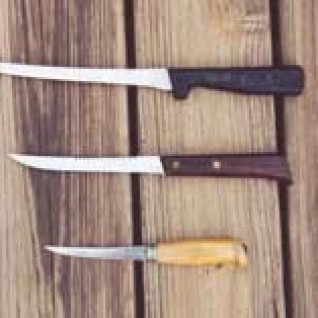 A good fillet knife is an important piece of equipment for sportsmen and women who want to get the most out of their angling efforts by properly preparing, cooking and eating the fish they land.
A good fillet knife is an important piece of equipment for sportsmen and women who want to get the most out of their angling efforts by properly preparing, cooking and eating the fish they land.
A distinctive, long, slender blade with a sweeping line and a good deal of flexibility characterizes fillet knives. These special knives are made for the delicate work associated with filleting meat and fish, and they are a very important part of every fish and game cook’s kitchen tool collection.
Look For Flexibility, Sharpness
Notice I said, “kitchen tool collection,” and that is where the trouble starts — in the kitchen! Of all the attributes possessed by a fillet knife, flexibility and sharpness are the  most important. Have you ever tried to properly remove the skin from a walleye or northern pike fillet using a knife that is too stiff or dull? Or even tried to fillet a delectable walleye and end up “butchering” it because of a dull blade?
most important. Have you ever tried to properly remove the skin from a walleye or northern pike fillet using a knife that is too stiff or dull? Or even tried to fillet a delectable walleye and end up “butchering” it because of a dull blade?
The flexibility of a fillet knife is largely determined by the knife’s manufacturer, but a keen edge is something that must be preserved and periodically renewed by the user. Now, back to the kitchen, where most food knives are kept and where often the trouble starts.
Using a good fillet knife for rough, general kitchen chores will dull it quickly and render it nearly useless when you try to use it for its intended purpose — filleting.
Caring for a fillet knife may involve storing it apart from other kitchen knives in a safe place where other family members won’t be tempted to use it for hacking stale bagels, or dicing carrots. Educating your fellow knife users as to the proper care and use of a quality fillet knife also will help a great deal.
When sharpening a good knife we like to use an oilstone. Most sharpening stones come with directions for their use in sharpening or “touching up” a dull knife. The basics include utilizing a light honing oil to lubricate the stone and holding the blade at approximately a 20-degree angle, while using a motion with the blade that imitates trying to push a thin slice off the top of the stone. One then turns the blade over and using the same angle, tries to pull a thin slice off the top of the stone. Some sharpening stones come with a device that keeps the blade at the proper angle while it is drawn along the stone.
Others may use a sharpening steel or ceramic stick to restore a slightly dull blade.
Don’t Abuse It
Don’t forget that care should be used when handling any knife. Treat knives with respect and remember that after correct sharpening, a knife will be very sharp and its mere touch may inflict a cut.
Many anglers like to keep a fillet knife in their tackle box in order to filet back in camp, while some fishermen often carry a small fillet knife for cleaning and cutting their catch out at a remote lake for a traditional shore lunch. Here the same principles apply. Don’t use a fillet knife to cut bait, fishing line or rope if you want that knife to stay sharp. Use a pocketknife or an old hunting knife for such purposes and save the fillet knife for food preparation.
Most people rightly associate fillet knives with fish, but one of the handiest uses for a sharp, flexible fillet knife involves the breasting-out or boning of the breast meat when cutting up a pheasant, duck, game hen or even a chicken. As in all filleting, you want to leave as little meat on the carcass as possible, and again that means a sharp, flexible blade.
If you care for a fillet knife properly you may be surprised at how well it will work for you, and how infrequently it will need major sharpening.
CHECK OUT OUR HUNTING BLOG: ON TARGET



